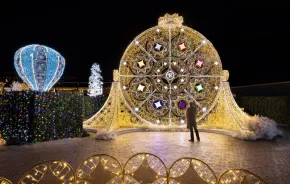
Editor's note: The Pacific Northwest Ballet has two terrific productions that are running (and ending) this weekend, and our dance reviewer took the challenge of seeing and reviewing both of them.
Le Corsaire is a boatload of ballet fun
Bottom line: Despite their historical role as bad guys, pirates are perennially popular in stories, and that tradition, Pacific Northwest Ballet School’s new production, Le Corsaire, is an entertaining introduction to Lord Byron’s poetic pirates. Note: There is only one performance left; book quickly!
Highlights: Relatives of budding young performers are dragged to recitals to witness their youngsters’ progress, and in principal the annual Pacific Northwest Ballet School production is no different. Except that it features middle and high school students who are on track for a professional dance career performing the same choreography that can be seen on professional stages. In recent years, the school has alternated between performing Snow White and Hansel and Gretel, but this year they have premiered a streamlined retelling of Le Corsaire, by the great Russian choreographer Marius Petipa.
This means a very traditional ballet with a lot of pointe work and extensive pantomime. Although somewhat more challenging for audiences than Snow White, the dancing in Le Corsaire is full of energy, with foot-stomping folk-inspired dances marked by — if not “yo hos” exactly, some cheering at least — that kids will copy during intermission. For families who miss the Stowell/Sendak Nutcracker, Le Corsaire includes elements in common with that beloved classic, including a bold young heroine who travels in a boat with her beau to an exotic land ruled by a Pasha and spends much of the second act being entertained by dancers.

Pirates make problematic heroes, and in this case Corsair Conrad is ennobled by his quest to rescue his true love Medora, whose own much more reliable moral compass leads him away from his life of crime. Le Corsaire, much like another famous pirate tale, glosses over the kidnapping and pillaging while focusing on the swashbuckling and romance. Considering the original ballet premiered in 1863, PNB School has done an admirable job of presenting both the heroine Medora and a corps de ballet-worth of kidnapped village girls with both strength and agency. An actor (Tim Hyland) shares the stage with the dancers and provides narration to clarify potentially confusing scenes.
Le Corsaire is a rollicking vehicle for showcasing the talents of a new generation of dancers and musicians — the orchestral accompaniment is provided by the Seattle Youth Symphony Orchestra. Its high energy and folky story make it easy to overlook (admittedly rare) foibles in the performance, while the classical choreography challenges young performers to demonstrate the full extent of their skills and guarantees the audience a performance worth the price of admission.
Parents should know: This is a perfect performance to bring the whole family. Ticket prices are lower than for the professional company, and the audience is so full of children that no one will judge the occasional crying baby or inappropriately loud question. At 65 minutes, Le Corsair is a bit longer than previous PNB School performances. A 15-minute intermission ensures that young viewers’ stamina is not taxed.
A dance workshop, craft station (supplies for making eye patches are provided) and musical instrument petting zoo are set up in the lobby before the performance. Many patrons are choosing themed garb for this particular production.
Parent tips
• Booster seats are available at no cost.
• The concession stands are open during this production, but the popular ballerina cupcakes that are often offered during family-friendly PNB productions are not available.
If you go...
- Where and when: There is only one performance remaining, Saturday March 26 at 3:30 p.m.
- Tickets: Prices range from $23-$60 and can be purchased online.

Director’s Choice ballet is a surprise hit for families
The annual Director’s Choice program at Pacific Northwest Ballet is intended to showcase the skill of the company’s dancers and expose the audience to more challenging work, rather than introduce children to the art form. But the three dances featured this year are so propulsively energetic and emotionally expressive that even the youngest viewers will be engaged and delighted.
One of the things I love best about dance is that it expresses feelings in a direct, accessible way that words often can’t. So it was that the first piece in Pacific Northwest Ballet’s Director’s Choice program, Rush, made nonverbal sense of a flood of early adolescent emotions. A Seattle pre-teen can relate to the feelings of fear and frustration expressed by arms outstretched like the spines of a liquidambar fruit without knowing that the dark, richly textured score by Czech composer Bohuslav Martinu was written in the anxious weeks before the Munich Agreement gave the Nazis control of his homeland. A parent can only hope that the grace and beauty with which the choreography by PNB’s own ballet master Paul Gibson expresses those emotions is something youth can learn from as well.
Peek-a-boo is one of the first causes of laughter in a child’s life. It’s a game they outgrow quickly, but delight in the unexpected remains a foundational element in humor. Alejandro Cerrudo’s “Little Mortal Jump” delightfully defies expectations from start to finish. As the lights dim, a young man races down the aisle. He must be rushing to his seat after intermission, but … who wears suspenders to a matinee in Seattle? He crosses the auditorium in front of the orchestra pit before climbing up on stage just as the music starts. It is a pop song.
The score is a mixtape combining artists as disparate as Tom Waits and Philip Glass yet woven together so deftly that it could be mistaken for a single piece of music. The choreography likewise comprised unexpected movements drawn from outside of the traditional ballet vocabulary. Female dancers support the weight of their male partners; dancers in Velcro suits get stuck to moving walls or walk right off the stage, dropping into the empty orchestra pit. “Little Mortal Jump” is as laugh-out-loud funny as Donald O’Connor’s famous routine in Singin’ in the Rain, and every bit as accessible to all ages.

Justin Peck’s “Year of the Rabbit,” with music by Sufjan Stevens, explores the Chinese zodiac using a combination of the traditional ballet seen in “Rush” and the unusual elasticity of “Little Mortal Jump.” My family has an interest in Chinese astrology, and so particularly enjoyed trying to match the styles in each movement to the characters of the Zodiac. Afterwards we talked about whether the dances resembled the animals they were named for or the personalities attributed to people born in those years. But even without the thematic connection, the urgency and athleticism of the piece was engaging.
Director’s Choice is a chance for the ballet to present more unusual pieces and take some artistic risks. Two of the three dances in the program this year are PNB premieres. Audiences don’t always know what to expect, and for families on a limited budget, it’s tempting to stick with the tried and true. But this year, Director’s Choice is one the whole family can enjoy.
Parents should know: Conventional wisdom says that children should be introduced to ballet through traditional story ballets, ideally fairy tales or dances like Nutcracker, which use a lot of children on stage. But unlike other performance arts, dance has an immediacy that children can relate to without much help from parents. Children are often better able to accept the abstraction of dance more easily than adults. Simply saying, “These dancers are really strong and graceful, and this is how the music makes them want to move their bodies,” may be all the preparation a child needs to appreciate ballet.
If you go...
- Where and when: Marion Oliver McCaw Hall at Seattle Center, 321 Mercer Street
Shows at 7:30 p.m. Thursday, March 24; Friday, March 25 and Saturday March 26; 1 p.m. Sunday, March 27
- Tickets: All family members must have a ticket, even babes in arms. Tickets range from $37-$142. Feel confident purchasing tickets appropriate to your budget as the sightlines and sound quality are good everywhere in McCaw Hall. Tickets can be purchased online.
- Tips: Watch an excerpt from “Year of the Rabbit” online.











